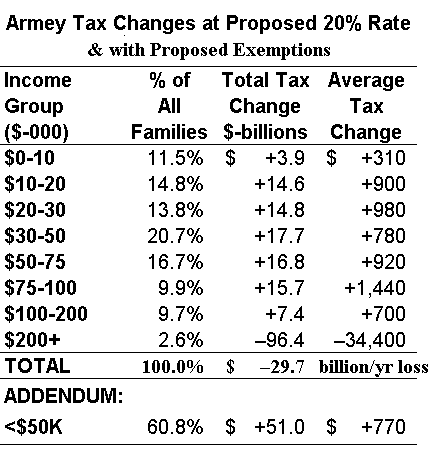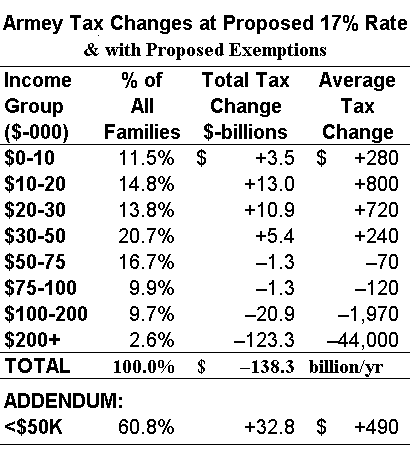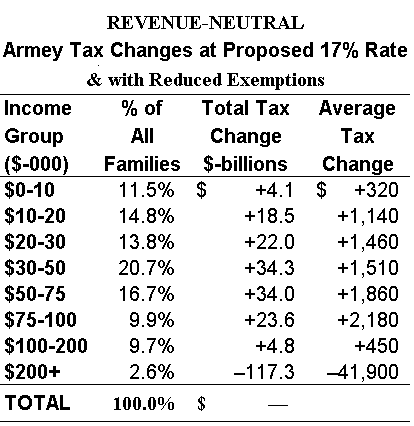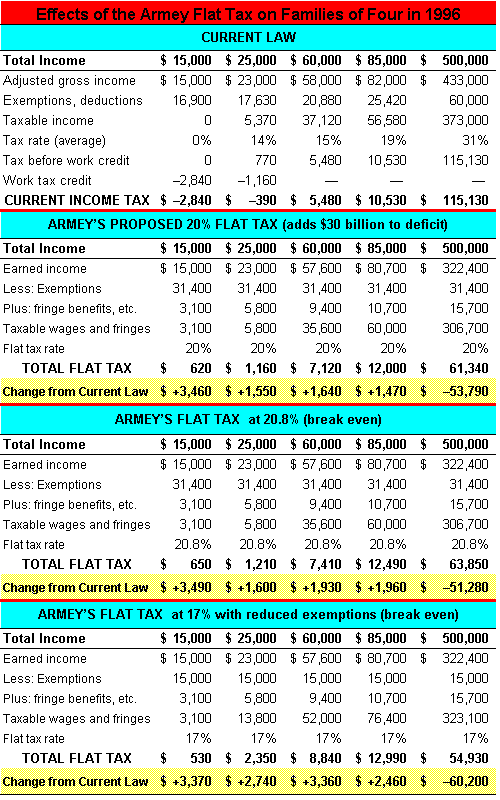February 1, 1996 02:23 PM | Permalink | 
By Robert S. McIntyre
“The one thing I will not do is shift the tax burden from the super rich to the middle class,” Bob Dole told a GOP audience on Jan. 20 in New Hampshire. “You won’t tolerate that and I won’t tolerate it and it’s not going to happen.”
Suppose we, too, can agree that halving the top income tax rate on the rich, wiping out taxes on interest, dividends, capital gains and inheritances, and raising taxes on the vast majority of Americans–i.e., the “flat tax”–is a very bad idea. What then? Is there anything at all to like about the flat tax idea? Or should the direction of tax reform be something completely different?
With the notable exception of Dole, GOP presidential candidates are falling over each other to endorse some version of a “flat tax”–and to attack, often viciously, the others’ versions. (Malcolm S. Forbes, Jr.’s flat tax plan “looks like it was cooked up at the yacht basin,” complains GOP rival Pat Buchanan, who has his own, undefined flat tax plan.) The various GOP flat-tax plans do have some notable differences, but all have one item in common. They would compress the current, graduated tax rates into a single rate.
But progressive rates are one thing about the current income tax system that the vast majority of voters should love. Because the richest people pay the highest rates, middle-income families pay less–and low-income people pay no income tax at all. (Indeed, low- and moderate-income working families actually get an income tax rebate under the current system, as a way to offset their social security payroll taxes.) No change at all looks better than losing this critical feature of our current system.
The stakes for most people are far from trivial. A recent Treasury analysis of House Majority Leader Richard Armey’s flat-tax plan conservatively found that under Armey’s proposed 20 percent tax rate (for its first two years), taxes would go up by an average of close to $1,000 a year or more for families in every income group except those earning more than $200,000. Even so, at a 20 percent rate the plan loses at least $30 billion a year in revenues–because the tax cuts in the highest income group are gargantuan.
This fundamental problem is not solved by adding back a few of the deductions that Armey would repeal, as some flat taxers propose. The truth is that virtually any flat-rate tax plan that adds up must, by simple arithmetic, produce huge tax cuts for those with the highest incomes and therefore big tax increases on almost everyone else.
Many flat taxers try to fudge this issue by proposing a ridiculously low tax rate coupled with impossibly large family exemptions. Armey with his 17 percent tax rate starting in the third year, Forbes with a 17 percent rate and even larger exemptions right away, Sen. Phil Gramm (R-Tex.), who tries to one-up Forbes with a 16 percent rate, and the Kemp Commission with an unspecified rate and exemptions, but a plethora of deductions, face budget-busting revenue losses ranging from $140 billion a year to upwards of $300 billion annually. (That compares to about $750 billion in income and estate tax receipts under current law.) Their preposterous responses to these enormous revenue shortfalls are either to call vaguely for closing down much of the government or to rely on fatuous supply-side predictions of a doubling or tripling in the economic growth rate.
The hook that flat taxers are trying to snag us with is “simplification.” But there is nothing simpler about a single tax rate versus several rates. After all, which is easier: multiplying your taxable income by, say, 21 percent or looking your taxes up in a table where the arithmetic has already been done for you?
That leaves how we define what’s taxed. Many people believe that the current income tax system is so ridden with loopholes that the rich get away tax-free, or close to it. There’s more than a grain of truth in that feeling, but it’s vastly overstated. Although some very high-income people (and some big, profitable corporations) use loopholes to pay far less than they should, on average the top earners pay a higher share of their total income in income taxes than do ordinary families.
That’s why the current income tax–both personal and corporate– while far from perfect, is the central progressive element of our overall tax system. Almost all the other taxes we face–payroll, excise, sales, etc.–are regressive, hitting low- and middle-income people much harder than the wealthy.
And that’s why the flat-tax tribunes for the rich–or in Malcolm S. Forbes, Jr.’s case, the rich himself–want to keep all those regressive taxes while converting the progressive income tax into a regressive wage tax or a sales tax (including new taxes on employee fringe benefits). As GOP presidential candidate Richard Lugar (R-Ind.) says about his proposed flat-rate sales tax: “I admit that if the point of taxation is progressivity or so-called fairness and redistribution, then my plan will not be your cup of tea.”
For most of the flat taxers–who generally have never seen an upper-income tax break they didn’t like–the “simple” answer to the loophole problem is to consolidate the existing tax dodges for corporations and the wealthy into one all-encompassing loophole. Leading flat-tax plans from Forbes, Armey and the Kemp Commission would exempt capital income–interest, dividends, capital gains, etc.–from personal income tax entirely, and repeal the federal estate tax on the very largest estates to boot.
But lowering the taxable income of the rich is hardly what most people mean when they say they want a simpler tax code. On the contrary, the real answer to tax avoidance by the rich is to close the loopholes that make it possible. That entails cracking down on excessive “depreciation” write-offs, ending preferential treatment of capital gains, curbing multinational tax abuses and so forth. Reforms like these may or may not make the tax code simpler–often rules that are too simple are the easiest for lawyers and accountants to get around–but they would address most people’s real concern about complexity: that the rich aren’t paying their fair share.
What about itemized deductions, the major “complication” in income tax filing that large numbers of ordinary families actually face? Most of these tax breaks are popular because they’re intended to help ordinary people–not to give unfair advantage to a favored few. In fact, you can make a good case that deductions for state and local taxes, extraordinary health costs and charitable contributions make the tax laws fairer. And, of course, mortgage interest deductions can be pretty important to homeowners struggling to make ends meet. That doesn’t mean we have to keep every itemized deduction, but it is suspicious that the flat-tax “reformers” generally target some or all of these mainly middle-class deductions for elimination while vastly expanding other loopholes for those at the top of the income scale.
If we really want a simpler tax system, we don’t have to throw fairness or fiscal responsibility out the window. Instead, we need to broaden the tax base by removing unwarranted loopholes. House Minority Leader Richard Gephardt (R-Mo.) proposes closing about $50 billion a year in corporate loopholes and eliminating all itemized deductions except mortgage interest. That allows him to increase standard deductions and personal exemptions and put three out of four families in a 10% income tax bracket or less–but with higher rates on those who make the most.
The Gephardt plan reduces average taxes for every income group except those making more than $200,000 a year. The plan adds up because those at the very top would pay higher taxes. The Gephardt plan may not be perfect, but unlike the flat tax, it’s a reasonable starting ground for debating real tax reform.
Robert S. McIntyre is director of Citizens for Tax Justice.
![]()









